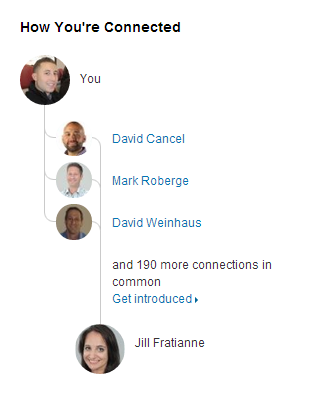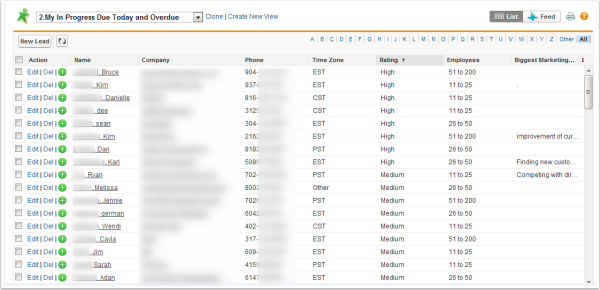It's go time. You just got a hot inbound lead and you're excited to make your first contact with them. In a typical sales environment you would have your script prepared and dial away, now you're ready to try something different. You're ready for inbound sales. Say goodbye to long days of calling names and numbers off of a list somebody found on the proverbial side of the road, and hello to getting real introductions to real people. Here's how you can learn how to research, organize, and begin the conversation with your inbound leads.

1. Research your Inbound Lead
When the leads are coming to you -- when they find your company's website through search or social based on your great content -- it can be far too easy to feel complacent and simply react without doing the proper research first. But researching your inbound lead before calling or emailing them back is critical to making an effective first start.
First, ask yourself:
 Is another person at my company working this lead already?
Is another person at my company working this lead already?
There's no sense in wasting even a second of your time if this lead is already being pursued by another rep at your company. It also can be upsetting to a lead to have to make you aware of their relationship with your officemate. Find out if this person is already in contact with another salesperson at your company.
Is this a real, legitimate lead?
Even if the lead is using an obviously fake name or phone number, check to see if the email is valid. Don't assume that all of the contact fields are incorrect just because some are.
Visit the company’s website. If the company doesn't seem to have one, search for them in Manta and Google to ensure that they have a physical location. All you should be concerned with here is to learn if the company is real, and if the lead is actually valid.
Next, verify the individual themselves. Is this person actually employed at the company they pretend to be? Verify their role and contact information. Find out if the company has a staff directory or a page of employee profiles on their site. Search for the lead on LinkedIn. Don't offer to connect yet -- just poke around and make sure this pseron is who they say they are.
Do I understand the company and business model?
In order to make an effective connection, it's important to be able to relate to the people you're speaking with. Explore the company’s "About Us" page. Click through and read their site for at least a few minutes to gain a general understanding of what they do.
Can anyone in my network make an introduction?
You should have your lead’s LinkedIn profile open in your browser. On the right side of the page you'll see a section called “How You’re Connected." Find out if there's someone you know well who can make the introduction for you. Also check to see if this lead is a member of a LinkedIn group or an association that you're involved with.
What is this lead thinking about right now?
You will inevitably gather quite a bit of information from these few simple searches. But the big win is using this information it to create context for your call. Use things like length of employment, the specific content your lead downloaded, their job role, and or their past experiences to try to understand where your lead’s interests lie at this moment.
2. Determine if your lead is a “good fit”
Now that you have your lead and your research on hand, you're ready to take what you've learned and compare it with what you know about your average customer.
First, focus on this lead's company. Is this a company you would like to be doing business with? Is this company capable of gaining value from your product or service? Here are a few key questions you can ask yourself to determine if your lead's company is a good fit:
- Do they have the staff required to operate or execute on what you offer?
- Would using your product or service disrupt their current model of internal operations?
- Is your offer likely to provide a clear ROI to the business?
Not every company will have a logical path to using your offering. Getting a "no" on any of these questions allows you to begin disqualifying your leads, which saves you time in the end. Be diligent in recognizing indications that your lead is poor fit.
3. Determine the value of your lead
Think of determining the value of a lead as making a plan on the number of times you are willing to call and email them based on the person within the organization you are targeting. A typical scale used to differentiate between lead values is high, medium, and low.
Over time you can create a list of leads that are good company fits, and whoare clearly rated based on a strategic scale of where you are willing to spend your time. When prospecting inbound leads, it is important to remember that you will touch base on the first call with many of your leads.

After you have placed a value on your inbound lead, you can design a predetermined schedule for how you plan to contact the lead, in the event that they don't answer on the first try.
4. Start the conversation
Now that you've researched your inbound lead and determined that they're a good fit to sell to, it's time to pick up the phone.
Be sure to have the key information on hand, such as company profile, details on the person you're calling, and what they downloaded. Draw from your research or from new sources to identify a constructive tip to provide your lead in order to create value and position yourself as a helpful expert.
Based on your typical sales process, remind yourself of the goal of this first contact. Are you looking to book an appointment, make an introduction, or win a deal? Understanding the goal of this call is essential to getting what you want out of it.
When your lead answers the phone, begin by introducing yourself and where you are calling from. At this point your lead is answering an unknown number and their primary concern is to discover who is calling. Emphasize the name of your company and remind them of the content they recently downloaded from you.
You can name it specifically:
“I saw you downloaded our ebook on '10 Ways to Improve your Business' the other day."
Or just mention it generally:
“Thanks for downloading our information about how to improve your business.”
Reminding them of their research leverages the true nature of inbound leads. They were the ones looking for information on something that they lacked and you are knowledgeable about. Be sure to remind them of this.
After you've warmed up the call by mentioning your company and their recent download, it's time to press forward towards your goal.
Here are two effective paths towards you can take:
1. “What are you looking for help with?”
Ask the lead an open-ended question that puts the ball in their court. What you're really doing is asking them to identify their primary reason for doing the research that led them to you.
Pros:
- The lead can now tell you what initiated their research, what challenges they are facing, who asked them to do research or any number of other key pieces of information.
- This can lead into a natural series of questioning where you can gather important qualification details and provide answers to topics they are investigating.
- If they are willing to answer this question, it's a very efficient path towards accomplishing your goal.
Cons:
- It's very easy for a lead who is skeptical of your call to sidestep this question with “Oh, I’m just doing research,” or “I still haven't read the ebook.”
"Here's a free tip."
Offer some free, helpful, expert advice based on what you discovered during your research. Keep it simple and actionable.
“I noticed you’re not [doing X]. If you make this simple change, you should see an improvement in your business.”
You are now establishing your expertise, offering constructive help, and determining the direction of the conversation.
Pros:
- You immediately position yourself as an expert.
- If the tip is in line with their interests and needs, you can get the conversation off to a very hot start and make much progress toward your goal (this is why research and preparation are so valuable).
- If the lead is strongly opposed to change, they will tell you that now, allowing you to adjust your sales process accordingly.
Cons:
- People can become defensive with criticism (do your best to be constructive).
- Regardless of the value of the tip, you could steer the conversation away from their key goals and needs.
When leading with a tip, you want to begin asking qualifying questions or by getting directly to your goal after the recognition of their acceptance that you add value.
These are just two paths to accomplishing your sales goals. Experiment with your introductions to get a better understanding of your buyer persona and what can guide them toward your goal.
What do you do to research your inbound leads before making that important first contact? How do you like to establish rapport and open the conversation? Let us know in the comments.
Michael Pici is an Inbound Marketing Specialist at HubSpot. He helps organizations develop strategies to attract highly qualified leads, and to use modern sales techniques to develop a holistic sales and marketing funnel. Michael is a top sales producer, and is the co-author of the Inbound Sales blog, Sell Inbound.



